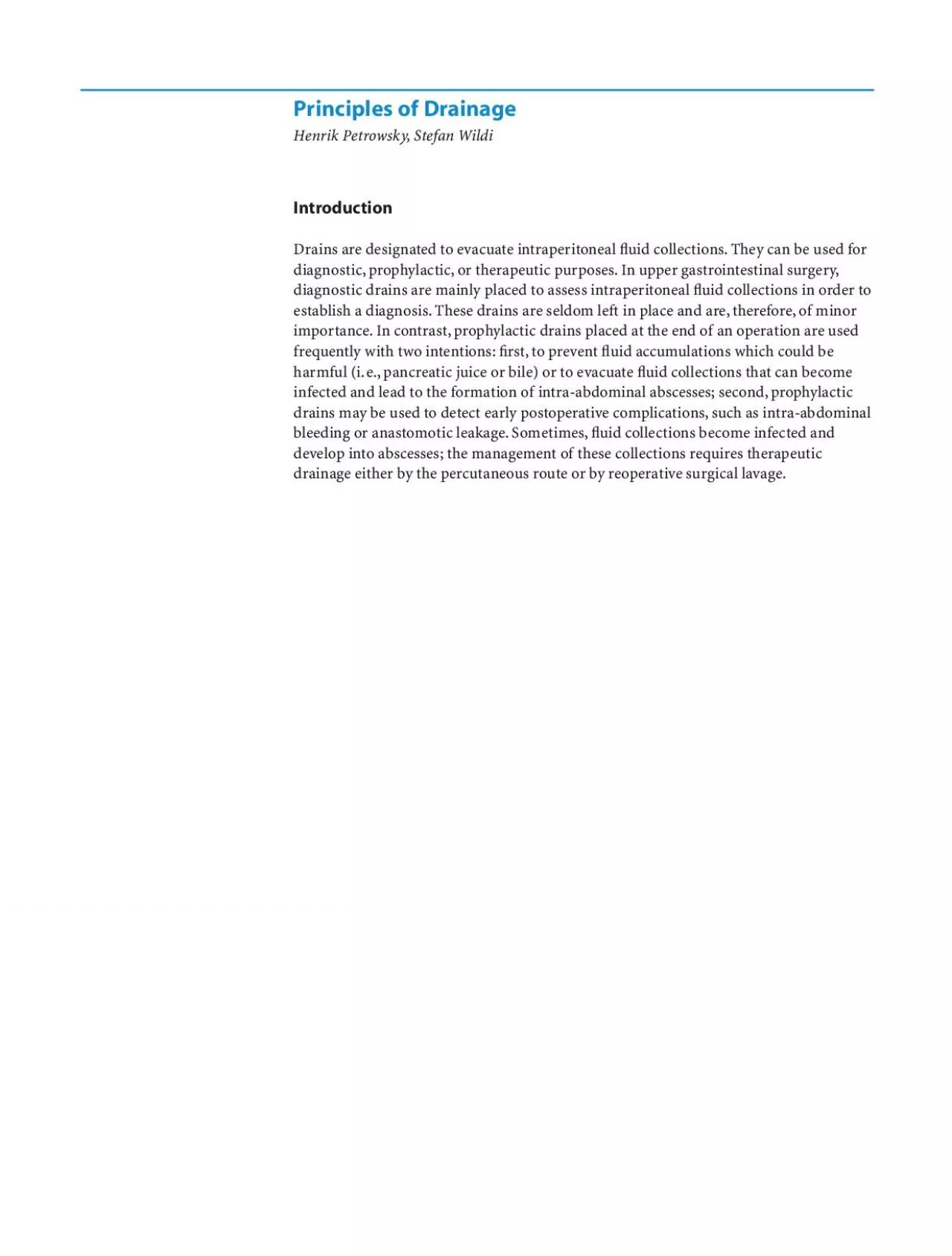

Sump DrainsSump drains are usually doublelumen tubes with a larger out148ow lumen and a smallerin148ow 141sump142lumenThe larger lumen is connected to a suction system and evacuatesintra ID: 951419
Download Pdf The PPT/PDF document "Aktive DrainsJacksonPratt and Blake dr..." is the property of its rightful owner. Permission is granted to download and print the materials on this web site for personal, non-commercial use only, and to display it on your personal computer provided you do not modify the materials and that you retain all copyright notices contained in the materials. By downloading content from our website, you accept the terms of this agreement.
Aktive DrainsJackson-Pratt () and Blake () drains are commonly used radiopaque,siliconeproducts for closed-suction systems.The Jackson-Pratt drain is oval-shaped withnumerous ori“ces and intraluminal corrugations (inlay).The Blake drain has four chan-nels along the sides with a solid core center.In contrast to passive drains,active orsuction drains maintain a negative pressure gradient. Sump DrainsSump drains are usually double-lumen tubes with a larger out”ow lumen and a smallerin”ow
sumpŽlumen.The larger lumen is connected to a suction system and evacuatesintra-abdominal secretions.The smaller lumen serves as a venting tube,allowing air toenter the larger lumen.This principle should help to break the vacuum in the largedraining tube,maintaining the drain in a productive state,without the surroundingtissues continually occluding the drainage holes in the tube.Sump drains are often usedwhen large ”uid volumes have to be evacuated.The occlusion ofthe smaller venti
ng tubeby tissue debris due to retrograde in”ow demonstrates a potential disadvantage ofsumpdrains that occurs especially when the suction is disconnected.Some sump drains havean additional third lumen that allows the instillation ofan irrigating solution. Principles of Drainage A-1 A-2 A-1 A-2 SuctionDrainage Complete Drainage SystemCollapsible devices connected to the drain tubes automatically generate a negative pressure gradient and keep the system sealed,Žwhich is believed to re
sult in a signi-“cant reduction ofretrograde infections. SECTION1General Principles Table1.Advantages and disadvantages of open and closed-suction drains Open drainClosed-suction drainAdvantagesGenerates pathways for bulky Lowers risk ofretrograde infectionor viscous materialLowers risk ofmechanical Accurate measurement ofdrainageerosion and pressure necrosisFacilitates radiographic studiesSkin protection from irritating dischargeDisadvantagesRetrograde infectionMore vulnerable to obstruction b
y small tissue fragments or ingrowth ofsurrounding tissue Anastomosis DrainsAnother proposed function ofprophylactic drainage is the early detection ofanasto-motic leakage.Ifdrains are to be used near a high-risk anastomosis,it is important thatthey are not placed in direct contact with the anastomosis,but,rather,with a safetymargin in between to prevent drain-related erosions.This principle is illustrated for abiliodigestive anastomosis,where the drain is placed posterior to the anastomosis.Althou
gh the routine use ofprophylactic drainage has often been considered as a method to prevent complications,there is growing evidence that this practice may be associated with adverse effects.Retrograde drain infections or drain-related compli-cations are known adverse effects.Several randomized,controlled trials are availableinvestigating the routine use ofprophylactic drainage (Table2). Principles of DrainageTable2.Evidence-based recommendations for prophylactic drainage practice not assessedOnly on
e randomized controlled trial in pancreatic cancer Therapeutic Drainage Predisposed Spaces for CollectionsInfected collections,such as abscesses or infected bilomas,are known complicationsafter upper abdominal surgery and require drainage by operative or radiologicallyguided drain placement.The right subphrenic space (),left subphrenic space (Morisons pouch (),left subhepatic space (),and omental sac () are anatomic spacesthat predispose to abscess development. SECTION1General Principles Cathe
tersThe majority ofpostoperative collections in the upper abdomen are manageable bymeans ofpercutaneous drainage by interventional radiologic techniques using standardaseptic technique and local anesthesia.Thereby,collections are drained percutaneouslyunder ultrasonographic or CT guidance using the Seldinger or trocar techniques.This“gure illustrates a typical percutaneous drainage catheter,the MAC-LOC () that canbe inserted by the introduction cannula () or the trocar stylet ().The catheter ha
slarge,oval side ports to increase the drainage capability,as well as a radiopaque bandthat helps to identify the proximal area ofthe loop.This type ofself-lockingŽloopcatheter has memory,Ži.e.,the loop at the end can be straightened during insertion byintroducing a stylet intraluminally.After the catheter is positioned in place,the stylet is removed,and the loop reforms.This loop prevents displacement ofthe catheter.Some ”uid collections may require surgical drainage with
repeated abdominal lavageand second-look procedures (Table3). Principles of Drainage Table3.Criteria for percutaneous and surgical drainage of infected collections Percutaneous drainageSurgical drainageUnilocular collection/abscessMultilocular collections/abscessesLow viscosity ofdrain ”uidMultiple,non-communicating collectionsDrain route not traversing intra-abdominal High viscosity ofdrain ”uidorgans or thoraxPercutaneous drain route traversing intra- abdominal organs or thorax A-1 A-2